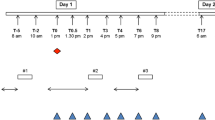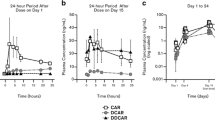Abstract
Rationale
Receptor occupancy study has been performed to evaluate pharmacokinetic profiles in new antipsychotic drug development. While these findings highlight the value of positron emission tomography (PET) for dose-finding study, what is unclear is if it is necessary to conduct these studies in patients with schizophrenia or whether studies in healthy volunteers are adequate.
Objectives
To determine if it is necessary to conduct dopamine receptor occupancy studies in patients with schizophrenia or whether studies in healthy volunteers are adequate for dose-finding study, we compared the concentration–occupancy relationship in terms of EC50 between patients and healthy volunteers.
Methods
Ten healthy volunteers and eight patients with schizophrenia participated in the study. We measured dopamine receptor occupancy using [11C]raclopride PET and plasma concentration of YKP1358, a novel antipsychotic drug under clinical development, at a number of time points after the administration of YKP1358. Pharmacokinetic data including area under the plasma concentration versus time curve, elimination half-life, maximum observed plasma concentration, and the time to reach the maximum observed plasma concentration were obtained. We explored the relationship between plasma concentration and dopamine D2 receptor occupancy using E max model and calculated EC50.
Results
The elimination half-life was longer in healthy volunteers than in patients. Other pharmacokinetic parameters were not significantly different between two groups. The EC50 was 7.6 ng/ml (95% confidence interval (CI) 6.2–9.0) in healthy volunteers and 8.6 (95% CI 7.4–9.9) in patients.
Conclusions
The antipsychotic concentration–occupancy relationship in patients can be estimated from the EC50 data of healthy volunteers.



Similar content being viewed by others
References
Arakawa R, Ito H, Takano A, Takahashi H, Morimoto T, Sassa T, Ohta K, Kato M, Okubo Y, Suhara T (2008) Dose-finding study of paliperidone ER based on striatal and extrastriatal dopamine D2 receptor occupancy in patients with schizophrenia. Psychopharmacology (Berl) 197:229–235
Arakawa R, Ito H, Takano A, Okumura M, Takahashi H, Takano H, Okubo Y, Suhara T (2010) Dopamine D2 receptor occupancy by perospirone: a positron emission tomography study in patients with schizophrenia and healthy subjects. Psychopharmacology (Berl) 209:285–290
Bench CJ, Lammertsma AA, Dolan RJ, Grasby PM, Warrington SJ, Gunn K, Cuddigan M, Turton DJ, Osman S, Frackowiak RS (1993) Dose dependent occupancy of central dopamine D2 receptors by the novel neuroleptic CP-88,059-01: a study using positron emission tomography and 11C-raclopride. Psychopharmacology (Berl) 112:308–314
Burt DR, Creese I, Snyder SH (1977) Antischizophrenic drugs: chronic treatment elevates dopamine receptor binding in brain. Science 196:326–328
Catafau AM, Penengo MM, Nucci G, Bullich S, Corripio I, Parellada E, Garcia-Ribera C, Gomeni R, Merlo-Pich E (2008) Pharmacokinetics and time-course of D(2) receptor occupancy induced by atypical antipsychotics in stabilized schizophrenic patients. J Psychopharmacol 22:882–894
Ginovart N, Wilson AA, Hussey D, Houle S, Kapur S (2009) D2-receptor upregulation is dependent upon temporal course of D2-occupancy: a longitudinal [11C]-raclopride PET study in cats. Neuropsychopharmacology 34:662–671
Howes OD, Egerton A, Allan V, McGuire P, Stokes P, Kapur S (2009) Mechanisms underlying psychosis and antipsychotic treatment response in schizophrenia: insights from PET and SPECT imaging. Curr Pharm Des 15:2550–2559
Inoue M, Suhara T, Sudo Y, Okubo Y, Yasuno F, Kishimoto T, Yoshikawa K, Tanada S (2001) Age-related reduction of extrastriatal dopamine D2 receptor measured by PET. Life Sci 69:1079–1084
Ito H, Hietala J, Blomqvist G, Halldin C, Farde L (1998) Comparison of the transient equilibrium and continuous infusion method for quantitative PET analysis of [11C]raclopride binding. J Cereb Blood Flow Metab 18:941–950
Kapur S, Zipursky R, Jones C, Remington G, Houle S (2000) Relationship between dopamine D(2) occupancy, clinical response, and side effects: a double-blind PET study of first-episode schizophrenia. Am J Psychiatry 157:514–520
Kegeles LS, Slifstein M, Frankle WG, Xu X, Hackett E, Bae SA, Gonzales R, Kim JH, Alvarez B, Gil R, Laruelle M, Abi-Dargham A (2008) Dose-occupancy study of striatal and extrastriatal dopamine D2 receptors by aripiprazole in schizophrenia with PET and [18F]fallypride. Neuropsychopharmacology 33:3111–3125
Kim E, Howes OD, Yu KS et al (2011) Calculating occupancy when one does not have the baseline—a comparison of different options. J Cereb Blood Flow Metab (in press)
Lammertsma AA, Hume SP (1996) Simplified reference tissue model for PET receptor studies. Neuroimage 4:153–158
Laruelle M (1998) Imaging dopamine transmission in schizophrenia. A review and meta-analysis. Q J Nucl Med 42:211–221
Lee T, Seeman P, Tourtellotte WW, Farley IJ, Hornykeiwicz O (1978) Binding of 3H-neuroleptics and 3H-apomorphine in schizophrenic brains. Nature 274:897–900
Lim KS, Kwon JS, Jang IJ, Jeong JM, Lee JS, Kim HW, Kang WJ, Kim JR, Cho JY, Kim E, Yoo SY, Shin SG, Yu KS (2007) Modeling of brain D2 receptor occupancy–plasma concentration relationships with a novel antipsychotic, YKP1358, using serial PET scans in healthy volunteers. Clin Pharmacol Ther 81:252–258
Mackay AV, Iversen LL, Rossor M, Spokes E, Bird E, Arregui A, Creese I, Synder SH (1982) Increased brain dopamine and dopamine receptors in schizophrenia. Arch Gen Psychiatry 39:991–997
Mamo D, Graff A, Mizrahi R, Shammi CM, Romeyer F, Kapur S (2007) Differential effects of aripiprazole on D(2), 5-HT(2), and 5-HT(1A) receptor occupancy in patients with schizophrenia: a triple tracer PET study. Am J Psychiatry 164:1411–1417
Mamo DC, Uchida H, Vitcu I, Barsoum P, Gendron A, Goldstein J, Kapur S (2008) Quetiapine extended-release versus immediate-release formulation: a positron emission tomography study. J Clin Psychiatry 69:81–86
McGuire P, Howes OD, Stone J, Fusar-Poli P (2008) Functional neuroimaging in schizophrenia: diagnosis and drug discovery. Trends Pharmacol Sci 29:91–98
Olsson H, Farde L (2001) Potentials and pitfalls using high affinity radioligands in PET and SPET determinations on regional drug induced D2 receptor occupancy—a simulation study based on experimental data. Neuroimage 14:936–945
Pien HH, Fischman AJ, Thrall JH, Sorensen AG (2005) Using imaging biomarkers to accelerate drug development and clinical trials. Drug Discov Today 10:259–266
Pleuvry BJ (2008) Hysteresis in drug response. Anaesth Intensive Care Medicine 9:372–373
Silvestri S, Seeman MV, Negrete J-C, Houle S, Shammi CM, Remington GJ, Kapur S, Zipursky RB, Wilson AA, Christensen BK, Seeman P (2000) Increased dopamine D 2 receptor binding after long-term treatment with antipsychotics in humans: a clinical PET study. Psychopharmacology 152:174–180
Sparshatt A, Taylor D, Patel MX, Kapur S (2010) A systematic review of aripiprazole—dose, plasma concentration, receptor occupancy, and response: implications for therapeutic drug monitoring. J Clin Psychiatry 71:1447–1456
Tauscher J, Jones C, Remington G, Zipursky RB, Kapur S (2002) Significant dissociation of brain and plasma kinetics with antipsychotics. Mol Psychiatry 7:317–321
Uchida H, Kapur S, Mulsant BH, Graff-Guerrero A, Pollock BG, Mamo DC (2009) Sensitivity of older patients to antipsychotic motor side effects: a PET study examining potential mechanisms. Am J Geriatr Psychiatry 17:255–263
Vernaleken I, Fellows C, Janouschek H, Brocheler A, Veselinovic T, Landvogt C, Boy C, Buchholz HG, Spreckelmeyer K, Bartenstein P, Cumming P, Hiemke C, Rosch F, Schafer W, Wong DF, Grunder G (2008) Striatal and extrastriatal D2/D3-receptor-binding properties of ziprasidone: a positron emission tomography study with [18F]fallypride and [11C]raclopride (D2/D3-receptor occupancy of ziprasidone). J Clin Psychopharmacol 28:608–617
Wong DF, Pearlson GD, Tune LE, Young LT, Meltzer CC, Dannals RF, Ravert HT, Reith J, Kuhar MJ, Gjedde A (1997) Quantification of neuroreceptors in the living human brain: IV. Effect of aging and elevations of D2-like receptors in schizophrenia and bipolar illness. J Cereb Blood Flow Metab 17:331–342
Acknowledgments
This study was supported by SK Corporation, Seoul, Republic of Korea (06-05003) and a grant of the Korea Healthcare technology R&D Project, Ministry of Health & Welfare, Republic of Korea (A070001). The investigational site, Clinical Trial Center of Seoul National University Hospital, is supported by a grant of the Korea Health 21 R&D Project, Ministry of Health and Welfare, Republic of Korea (A040154).
Author information
Authors and Affiliations
Corresponding author
Rights and permissions
About this article
Cite this article
Kim, E., Howes, O.D., Kim, BH. et al. The use of healthy volunteers instead of patients to inform drug dosing studies: a [11C]raclopride PET study. Psychopharmacology 217, 515–523 (2011). https://doi.org/10.1007/s00213-011-2306-4
Received:
Accepted:
Published:
Issue Date:
DOI: https://doi.org/10.1007/s00213-011-2306-4




